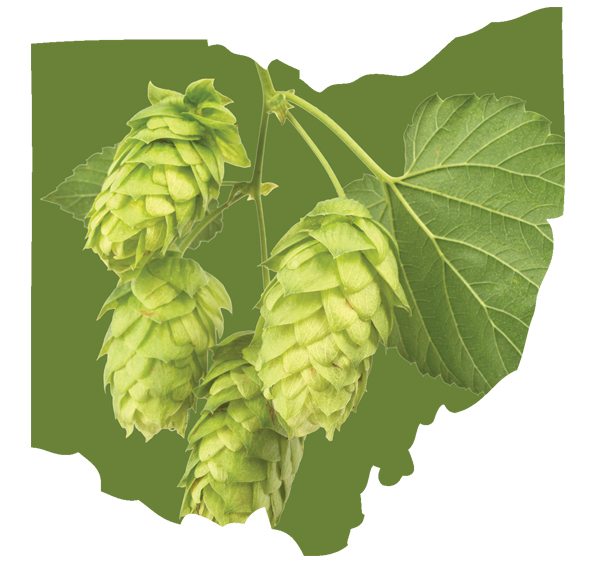
By Sarah Jaquay
Once upon a time the English dubbed hops a “wicked weed.” There are days when Tom Hoenie, co-owner of Mankato Farms in New Carlisle, Ohio, might agree. “It’s incredibly labor intensive,” he says. “You have to be creative and stubborn.” Hoenie is both. He’s proficient at growing Cascade, Chinook and Columbus hops. Craft breweries from Akron’s Hoppin’ Frog to The Dayton Beer Company and Cincinnati’s Christian Moerlein are satisfied customers. Hoenie has tasted the results. “It’s especially good when a brewery wants a wet-hopped beer as MadTree Brewing does every year.” (Most beers are made with dry hops and there’s a short window after harvest when brewers can make beer with fresh or green hops.)
Dave Volkman, co-owner of Ohio Valley Hops, concurs that wet-hopped beers provide a singular experience. “Green hops gives it a juiciness—a grassiness [depending on the variety] and makes it more herbaceous.” Hoenie and Volkman are among Ohio’s pioneer commercial hop producers. Hoenie has three acres planted and Volkman has one. That may sound small, but Hoenie says it takes around $10,000 per acre to start growing hops and get them to market. Since one plant yields approximately one pound, Volkman’s 900 plants will produce 800-900 pounds. Neither operation could provide any brewery’s total supply, so they go after niche brewers who want to source locally. In 2015, Ohio had about 200 acres of hops planted.
Both of these successful growers believe demand will grow with the “craft agriculture” movement and explosion of craft breweries. Ohio Valley Hops currently grows 11 varieties including Cascade, Chinook, Columbus, Santiam and Perle. His customers have included Cincinnati’s Urban Artifact and Little Fish in Athens. And while Pacific Northwest producers often beat him on price, they can’t beat him on providing fresh hops for local brewers.
Buckeye residents considering growing hops can get advice from OSU’s Ohio Agricultural Research and Development Center’s Horticulturalist Brad Bergefurd. Experienced growers are happy to share their knowledge; but Hoenie and Volkman want new entrants to think about the process beyond growing. It’s important to have access to a mechanical harvester (such as Volkman’s that’s attached to a tractor); a way to dry or cure the hops and a pelletizer to turn the dried plants into pellets ready for sale. Besides a mechanical picker, Hoenie has an oast house (or hop kiln) that dries hops in about 24 hours and a pelletizer.
While Hoenie and Volkman don’t employ lots of extra manual labor at harvest time (which can run from August to mid-September depending on the variety), they lease out their equipment when they’re not using it. Hoenie tells recruits, “I’ll pay you in beer and sunsets,” and Volkman suggests producers who pick by hand should buy lots of pizza and beer.
Another support system for Ohio’s budding hop culture is the Ohio Hop Growers Guild. It has about 60 members and its mission is to grow, educate and increase sales for the state’s hop growers. There appears to be plenty of room. OSU estimates there’s demand for about 6,000 acres.
There are several theories about why hops was once called the “wicked weed,” including anti-Saxon sentiment. Ohio hop growers just know it’s a crop poised for wicked growth.
See www.ohgg.org, www.mankatofarms.com and www.ohiovalleyhops.com for more information about growing hops in Ohio.

